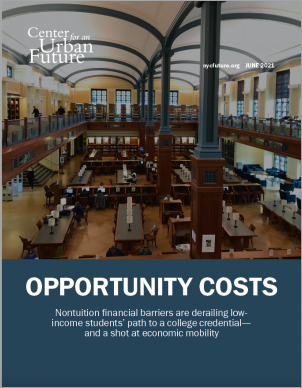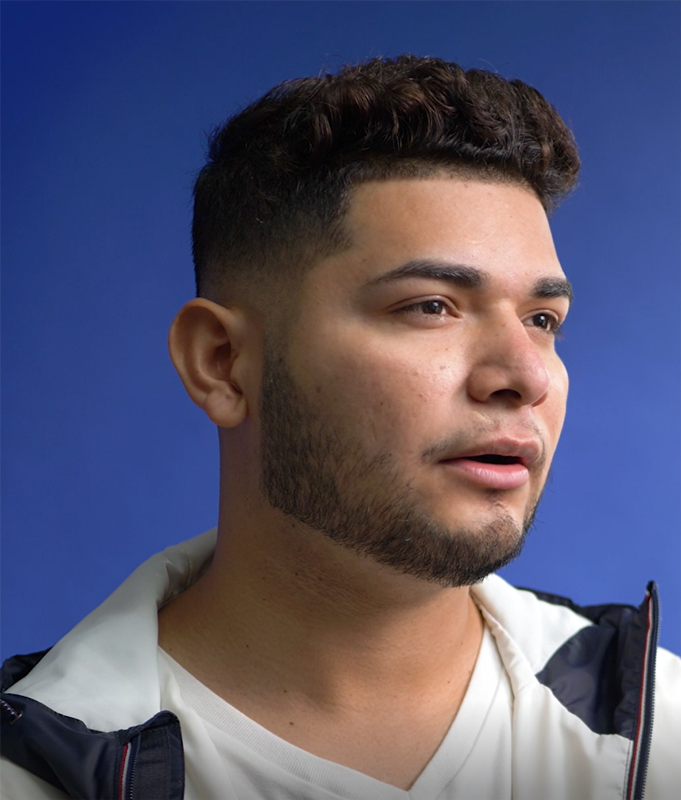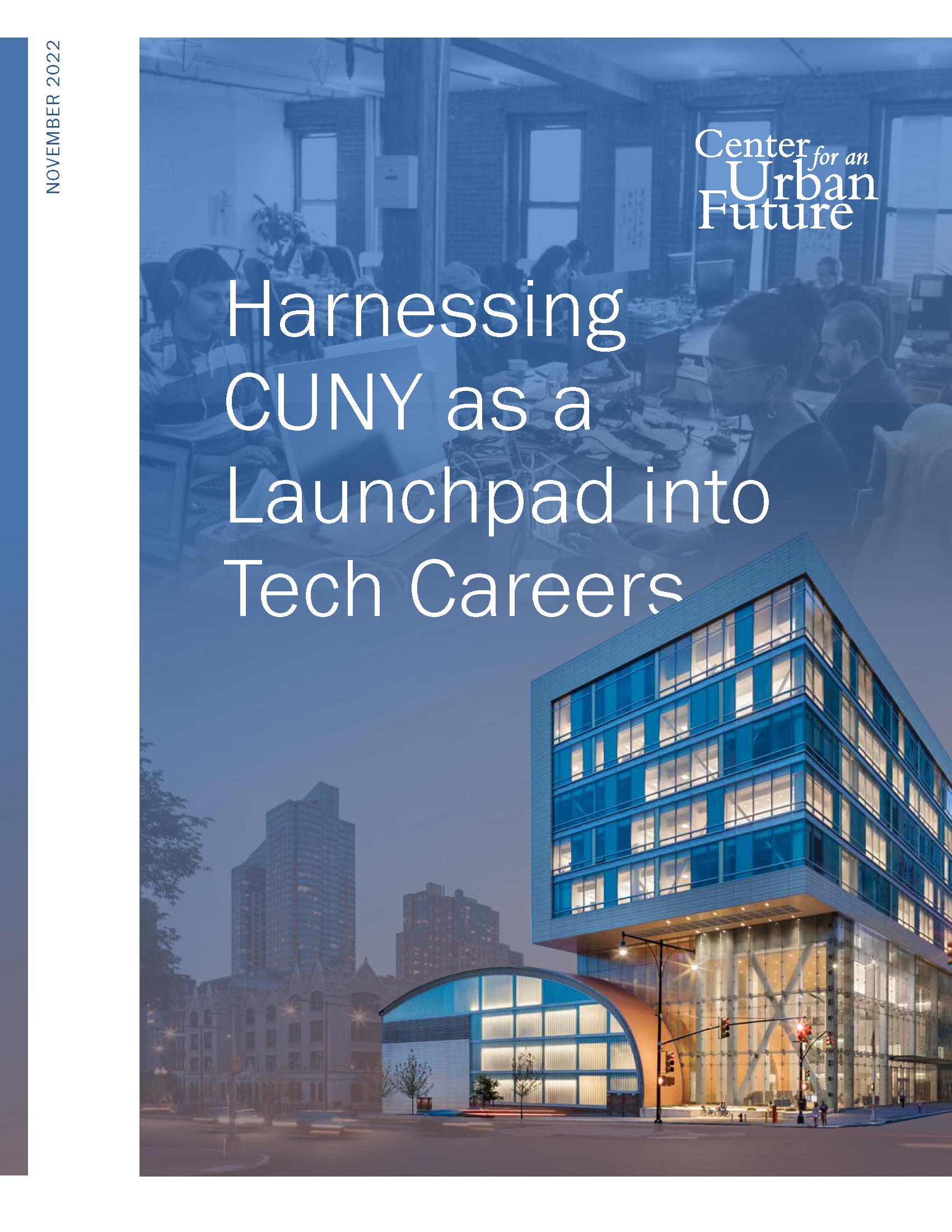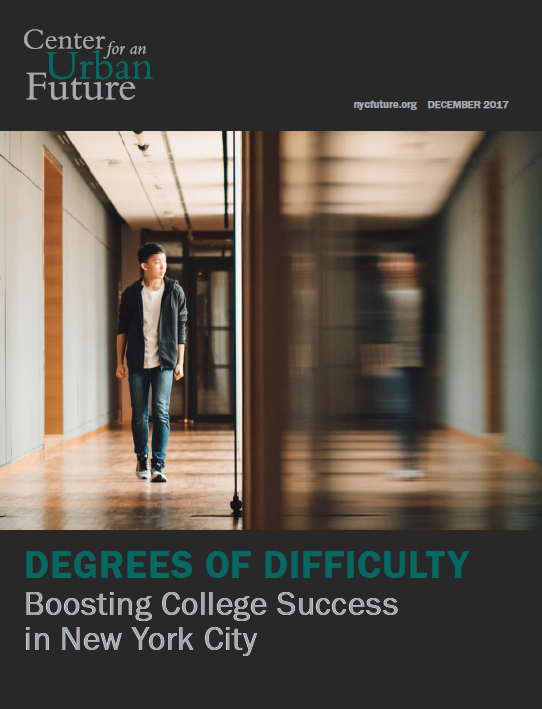Each year, CUNY’s seven community colleges serve as a gateway to economic mobility for tens of thousands of New Yorkers from low-income backgrounds seeking the skills and credentials to get ahead in a challenging economy. But the majority of CUNY students who enroll in associate degree programs never graduate—and for many students, non-tuition costs like a MetroCard, books, Internet service, food, and housing are the deciding factors that make it impossible to finish college.
In order to help New York cultivate an inclusive economic recovery from the COVID crisis, policymakers will have to help ensure that far more of New York’s lowest-income students can earn a postsecondary credential. Doing so will require New York City and State to do much more to help CUNY students tackle these non-tuition barriers to college completion. What follows are 20 practical and achievable recommendations for how policymakers, CUNY, and philanthropy can work together to alleviate non-tuition financial barriers and make significant further progress on boosting community college success.
Recommendations for the Mayor, City Council, and Candidates Running for Office
Make overcoming the non-tuition financial barriers facing community college students a key piece of NYC’s efforts to build a more equitable economy. One of the most effective things city policymakers can do to create a more inclusive economy is help a much larger share of the students who enroll at CUNY community colleges to remain in school and earn a credential. Research has shown that low-income students who do graduate from these institutions get a powerful boost, often catapulting into the middle class. But the majority of students who enroll in the city’s community colleges drop out without earning a credential. Mayor de Blasio, the City Council, and the candidates running for office in 2021 can change this by addressing the major cause of students dropping out: non-tuition financial barriers. CUNY simply doesn’t have the resources to address these financial challenges effectively on its own. City policymakers should step in and provide new resources to address the affordability gap tripping up far too many students and forcing them off the path to a better life. Specific steps city government officials can take include:
- Expand ASAP to every community college student. CUNY’s nationally renowned ASAP program, which has been shown to more than double graduation rates for students at CUNY community colleges, provides fully subsidized tuition and a free MetroCard and textbooks (as well as regular access to an academic advisor). But more support is needed to make ASAP a universal program for all CUNY community college students. We estimate that it would cost approximately $86 million in additional annual funding to scale up ASAP to reach every full-time community college student. A similar investment could help CUNY scale up the Part-Time Initiative to provide ASAP-like services to every community college, including those enrolled part-time. By more than doubling graduation rates, making ASAP universal could result over time in more than 16,000 additional community college graduates every year.
- Provide every NYC community college student with a free MetroCard. If there is one thing city policymakers should do to ease the affordability challenges that derail so many low-income community college students on the path to a credential, it is giving them a free MetroCard. Most CUNY community college students attend school tuition-free, but they struggle to overcome other expenses. None seems as prevalent as the challenge of affording a MetroCard, which came up again and again in our interviews with students as the single biggest financial barrier to completing college. Community college students that are part of CUNY’s highly successful ASAP program already receive a free MetroCard. City government officials should cover the costs needed to give a MetroCard to every other community college student. We estimate it would cost the city an additional $79.5 million per year to give a MetroCard to every CUNY community college student not currently in ASAP—funding that could also help support public transit while ridership remains far below pre-pandemic figures. A free MetroCard is about more than transportation—it helps relieve barriers that are harder to address, such as basic needs insecurity, by letting students put the money they save on transportation towards rent, food, and other pressing costs, and it supports students who are balancing the need to work with remaining in college.
- Provide funding for CUNY to expand zero-cost classes with no textbook costs. The mayor and City Council should join New York State in supporting CUNY’s transition toward zero-textbook-cost courses. Since 2018, New York State funding has allowed CUNY to establish open educational resources (OER), which are free to students and openly licensed. A relatively small city investment could match the current state funding and accelerate CUNY’s progress toward eliminating the cost of required books and course materials. This would alleviate a major cost burden for students, who can easily spend several hundred dollars a semester on textbooks and other course materials—saving community college students several million dollars annually.
- Help CUNY expand childcare on every campus. Nearly one in five CUNY community college students are parents, and they need to support their children before they are able to commit to school. CUNY’s childcare centers are an invaluable resource for parents who are able to use them, but they need to be expanded, and the university currently lacks the resources to do this on their own. Additional public support would allow CUNY to establish childcare centers at the two community colleges where they currently don’t exist, Queensborough and Guttman, and expand their childcare programming to include children less than two years old. With more resources, CUNY could also hire at least one counselor at each childcare center to support parents dealing with trauma and mental health issues and allow student-parents to use the childcare center while they study instead of just during their class hours. Because capacity is limited by space, schools should partner with local childcare centers to offer students vouchers for free or reduced-price childcare.
- Increase access to cheap or free food on campus. Food insecurity damages academic performance and pushes students to prioritize work over school—and far from being an anomaly, the majority of CUNY community college students lack reliable access to balanced meals. On-campus food pantries and help applying for SNAP benefits can give students assistance during emergencies. With additional resources, CUNY could expand its food supports and be better at supporting its food-insecure students day-to-day, especially since most food-insecure students don’t go to their campus food pantry. One way to do that is by expanding access to cheap or free on-campus food. CUNY should consider replicating Kentucky’s ONE cafeteria, which serves a balanced lunch for a dollar, or pilot a similar program.
- Restore the full range of Single Stop services on campus. CUNY’s partnership with Single Stop USA ended in June 2020; as a result, CUNY schools using the Single Stop name have rebranded their student resource centers, and some individualized services are no longer offered. New York City and State should provide a dedicated source of funding to continue providing the full range of services at each campus’ student resource center.
DYCD should incentivize and fund college persistence programs at community-based organizations. New York is home to a number of community organizations that have strong records of helping young people attain a high school diploma and apply to college. Our research suggests that these nonprofits are well-positioned to help New York’s low-income community college students overcome the financial hurdles that too often force them to drop out. Indeed, many of these nonprofits previously helped community college students attain a high school diploma and apply to college. But nonprofits say that virtually no city contracts intended to support at-risk youth, college access, and related programs include funding for college success programming—meaning that students often lose support as they transition from high school to college. The city’s Department of Youth and Community Development should retool current contracts and develop new RFPs designed to support college persistence and completion programs, with a focus on organizations serving community college students.
Recommendations for the Governor and Legislature
Strive for free tuition but prepare to embrace cheaper alternatives that reduce non-tuition barriers and expand TAP. The proposal to restore free tuition at CUNY that is part of the New Deal for CUNY bill introduced by Senator Andrew Gounardes and Assemblymember Karines Reyes would be a boon to thousands of New York’s community college students. But should the ambitious legislation fail to win enough support, the Legislature should embrace alternatives that would require fewer state dollars but still provide vital financial relief to CUNY’s low-income community college students. These options include:
- Fund initiatives to address non-tuition financial barriers facing community college students. The legislature should consider funding an expansion of campus childcare centers and food pantries or providing MetroCards and other transportation subsidies for all community college students.
- Sustain laptop and hotspot loan programs. Computer access is as necessary to succeed in class as access to the textbook—and even more so if distance learning becomes the new normal. But too many CUNY community college students can’t afford laptops. Last year, with the state’s support, CUNY purchased 50,000 new laptops, tablets, and other devices to help students fully participate in distance learning. Additional state support would help CUNY ensure that each of its community colleges is able to maintain a laptop loan program and expand the program with additional devices if demand necessitates.
- Expand and reform TAP to better meet the needs of New York’s lower-income community college students. The state’s Tuition Assistance Program (TAP) provides crucial financial aid to New Yorkers but excludes too many students, and it is far too easy for students to lose their TAP grants. TAP needs to evolve into a more effective program that aims to get all students to graduation. The state should make the following reforms to TAP to boost college success:
- Grant part-time students full access to TAP. Part-time students deal with the same economic barriers as full-time students, but most of them get little or no help with tuition. (Part-time TAP exists but is too restrictive to reach many students.) Restrictions on financial aid for part-time students are designed to encourage full-time enrollment—but because many students are part-time from economic necessity, the effect of that policy is to strip financial resources from some of the students who need them most. All part-time students should have access to TAP, and the ability to qualify for grants that fully cover the cost of tuition.
- Stop punishing students by taking away TAP. Students commonly lose TAP for academic reasons: Because they fail to meet standards for satisfactory academic progress or because they take classes unrelated to their major that aren’t considered “TAP-able” and put them below the credit threshold required for TAP eligibility. Both of these policies put students’ ability to stay in school at serious risk. The state should reconsider this punitive approach by eliminating rules around TAP-able credits and expanding part-time TAP eligibility, which can help ensure that students do not lose aid due to an unforeseen job loss or family emergency. If a student’s academic performance falls below current SAP thresholds, it should trigger an automatic alert to an academic counselor and any CBO with whom that student has a relationship—not a loss of TAP dollars.
- Raise income cutoffs for TAP so that more students qualify. Many students are above the income cutoff to be eligible for a grant that fully covers their tuition or for any amount of TAP at all. But those same students often struggle to afford basic costs of living while paying some or all of their tuition out of pocket—especially in high-cost New York City. The state should raise household income requirements to $100,000 so that more households are eligible for TAP and so that those that do qualify receive higher awards. The state should also pass legislation automatically raising the maximum TAP award to match the actual cost of tuition at SUNY and CUNY.
- Expand SNAP eligibility to serve all community college students in need. Under Governor Cuomo’s direction, the state Office of Temporary and Disability Assistance worked with CUNY and SUNY to implement a new policy expanding SNAP eligibility to low-income college students engaged at least half-time in career and technical education courses. But the state should go further and expand eligibility to all students enrolled at least half-time.
Recommendations for CUNY
- Expand hours at on-campus libraries. CUNY’s community college campus libraries are essential supports for the thousands of students who lack resources at home, such as a computer for writing essays and using software or Internet service to conduct research and submit course assignments. But current library hours are too limited considering the number of students who work, care for children, or have other obligations during the weekday. Campus libraries should be open until midnight and for the full day on weekends to accommodate students who lack a stable environment or resources needed to study.
- Screen every CUNY student for SNAP eligibility and other benefits. CUNY’s on-campus resource centers help many students receive SNAP and other public benefits, including those who didn’t know they qualified. But many students will never walk into a campus office, so CUNY’s approach needs to be more proactive: Every CUNY student should be screened for benefits. As part of the enrollment process at CUNY community colleges, every student applying for financial aid should also complete a short application to see if they and/or their family qualify for SNAP benefits. CUNY should also make a system-wide push to screen current students for SNAP eligibility.
- Partner with CBOs that offer assistance to housing-insecure students. More than half of CUNY community college students are housing insecure, with nearly one in five experiencing homelessness in the past year, and that instability puts college persistence at risk. CUNY should partner with CBOs to bring services to support those students onto community college campuses—including rent subsidies, utilities assistance, legal assistance and tenant representation, outreach, and advising related to housing. CUNY campuses should also strengthen their relationships with settlement houses and CBOs, where advisors can refer students who need emergency housing assistance.
- Allow CBOs to access data about their students. Community-based organizations are well equipped to do college persistence work and fill in some of the gaps in CUNY’s own resources. But they lack access to the data they need to be effective. Offering CBOs access to data is already being explored at CUNY: The Bronx Opportunity Network (BON) is developing a partnership with Bronx Community College and Hostos that would allow BON to access data about their students and intervene to help students who are most at risk of not persisting, as long as their students sign privacy waivers. This approach should be expanded across the system through standardized privacy waivers and could be expedited by supporting the work of CUNY’s Network for College Success to build data connections with CBOs.
- Expand relevant work opportunities for students, including virtual paid internships. Many students need to earn an income while in school and end up taking jobs in retail and food service that are unrelated to their course of study. CUNY should explore opportunities to create paid internship programs that offer 20 or more hours of work per week, with employers in fields relevant to courses of study at the community colleges. Those programs would mean that students’ work experience isn’t divorced from their experience in school—and those employers are less likely to expect students to prioritize work at the cost of doing well in school.
- Prioritize adapting key non-tuition financial supports to the post-COVID world. Whether classes resume on campus or distance learning continues for many months to come, CUNY’s important resources supporting students’ basic needs—from food pantries and childcare to benefits screening and financial counseling—will need to be revamped to manage post-COVID realities. CUNY should prioritize restoring these resources, which should include ensuring protocols and protective equipment are in place for childcare centers; developing virtual screening tools; creating or partnering with nonprofits to provide food deliveries to students in need; expanding access to remote mental health counseling services; and developing remote work opportunities for work-study students.
- Expand financial literacy education. While community college students badly need cash assistance—whether to pay for textbooks, transit costs, childcare, food, or other debilitating expenses—this financial aid should be coupled with financial literacy. One-on-one financial counseling can help students better balance work and school, prepare for an emergency, build credit, and learn about other supports available to them. College advisors and financial aid staff told us that students who have access to one-on-one financial counseling are better equipped to succeed in college, but that level of support is available to very few students today.












